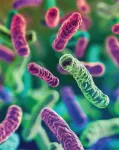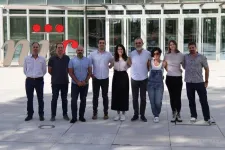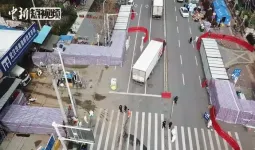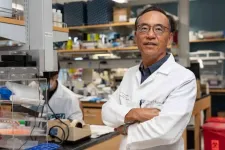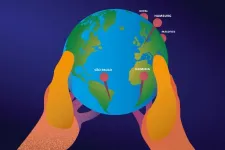(Press-News.org) A new international collaborative study provides a list of the wildlife species present at the market from which SARS-CoV-2, the virus responsible for the COVID-19 pandemic, most likely arose in late 2019. The study is based on a new analysis of metatranscriptomic data released by the Chinese Center for Disease Control and Prevention (CDC). The data come from more than 800 samples collected in and around the Huanan Seafood Wholesale market beginning on January 1, 2020, and from viral genomes reported from early COVID-19 patients. The research appears September 19 in the journal Cell.
“This is one of the most important datasets that exists on the origin of the COVID-19 pandemic,” says co-corresponding author Florence Débarre of the French National Centre for Scientific Research (CNRS). “We’re extremely grateful that the data exist and were shared.”
“This paper adds another layer to the accumulating evidence that all points to the same scenario: that infected animals were introduced into the market in mid- to late November 2019, which sparked the pandemic,” says co-corresponding author Kristian Andersen of Scripps Research.
“We have analyzed, in new and rigorous ways, the vitally important data that the Chinese CDC team collected,” says co-corresponding author Michael Worobey of the University of Arizona. “This is an authoritative analysis of that data and how it fits in with the rest of the huge body of evidence we have about how the pandemic started.”
On January 1, 2020, after the animals were removed and just hours after the market was closed, investigators from the Chinese CDC went to the market to collect samples. They swabbed the floors, walls, and other surfaces of the stalls; they came back days later to focus on surfaces in stalls selling wildlife, such as a cage and carts used to move animals, and then also collected samples from the drains and sewers.
They performed metatranscriptomic sequencing of the samples, a technique aiming to obtain all RNA sequences (and which can pick up DNA as well) from all organisms present in the samples—viruses, bacteria, plants, animals, humans. The Chinese CDC team, led by Liu Jun, published their data and results in 2023 in the journal Nature. However, the article left unresolved the exact identities of the animal species found in the data that could represent plausible intermediate hosts. The Chinese CDC shared their sequencing data on public and open repositories.
According to the latest analysis of these data being published in Cell, SARS-CoV-2 was present in some of the same stalls as wildlife sold at the market—including raccoon dogs (small fox-like animals with markings similar to raccoons) and civet cats (small carnivorous mammals related to mongooses and hyenas). In some cases, genetic material from the SARS-CoV-2 virus and these animals was even found on the same swabs. The exact animal species were identified by genotyping their mitochondrial genomes in the samples.
“Many of the key animal species had been cleared out before the Chinese CDC teams arrived, so we can’t have direct proof that the animals were infected,” Débarre says. “We are seeing the DNA and RNA ghosts of these animals in the environmental samples, and some are in stalls where SARS-CoV-2 was found too. This is what you would expect under a scenario in which there were infected animals in the market.”
“These are the same sorts of animals that we know facilitated the original SARS coronavirus jumping into humans in 2002,” Worobey adds. “This is the most risky thing we can do—take wild animals that are teeming with viruses and then play with fire by bringing them into contact with humans living in the heart of big cities, whose population densities make it easy for these viruses to take hold.”
The international team also performed evolutionary analysis of the earliest viral genomes reported in the pandemic, including these environmental sequences, and inferred the most likely progenitor genotypes of the virus that infected humans and led to the COVID-19 pandemic. The results imply that there were very few, if any, humans infected prior to the market outbreak. This is consistent with spillovers from animals to humans within the market. There may also have been spillovers of limited impact in the immediate upstream animal trade.
“In this paper, we show that the sequences linked to the market are consistent with a market emergence,” Débarre says. “The main diversity of SARS-CoV-2 was in the market from the very beginning.”
The new study landed on a short list of animal species in the wet market found co-occurring or close to viral samples that could represent the most likely intermediate hosts for SARS-CoV-2. The common raccoon dog, a species susceptible to SARS-CoV-2 and that carried SARS-CoV in 2003, was found to be the most genetically abundant animal in the samples from market wildlife stalls. Genetic material from masked palm civets, which were also associated with the earlier outbreak of SARS-CoV, was also found in a stall with SARS-CoV-2 RNA. Other species such as the Hoary bamboo rat and Malayan porcupines were also found to be present in SARS-CoV-2-positive samples, as well as a multitude of other species.
While the data cannot prove whether one or more of these animals may have been infected, the team’s analyses provide a clear list of the species that most plausibly could have carried the virus and genetic information that could be used to help trace where they originated.
The investigators stress the importance of understanding the origins of the COVID-19 pandemic, especially in light of other recent spillovers, such as the spread of avian flu viruses in cattle in the United States. “There has been a lot of disinformation and misinformation about where SARS-CoV-2 originated,” Worobey says. “The reason it’s so important to find out is that this affects national security and public health, not just in the United States but around the world. And the truth is, since the pandemic started more than four years ago, although there has been an increased focus on lab safety, not much has been done to decrease the chance of a zoonotic scenario like this happening again.”
###
Funding information can be found in the text of the paper.
Cell, Crits-Christoph et al. “Genetic tracing of market wildlife and viruses at the epicenter of the COVID-19 pandemic” https://cell.com/cell/fulltext/S0092-8674(24)00901-2
Cell (@CellCellPress), the flagship journal of Cell Press, is a bimonthly journal that publishes findings of unusual significance in any area of experimental biology, including but not limited to cell biology, molecular biology, neuroscience, immunology, virology and microbiology, cancer, human genetics, systems biology, signaling, and disease mechanisms and therapeutics. Visit http://www.cell.com/cell. To receive Cell Press media alerts, contact press@cell.com.
END
Human breast milk regulates a baby’s mix of microbes, or microbiome, during the infant’s first year of life. This in turn lowers the child’s risk of developing asthma, a new study shows.
Led by researchers at NYU Langone Health and the University of Manitoba, the study results showed that breastfeeding beyond three months supports the gradual maturation of the microbiome in the infant’s digestive system and nasal cavity, the upper part of the respiratory tract. Conversely, stopping breastfeeding earlier than three months disrupts the paced development of the microbiome and ...
The GENOXPHOS (Functional Genetics of the Oxidative Phosphorylation System) group at the Centro Nacional de Investigaciones Cardiovasculares (CNIC) has discovered a crucial role of sodium in the generation of cellular energy. The study, led by GENOPHOS group leader Dr. José Antonio Enríquez, also involved the participation of scientists from the Complutense University of Madrid, the Biomedical Research Institute at Hospital Doce de Octubre, the David Geffen School of Medicine at UCLA, and the Spanish research networks on frailty and healthy aging (CIBERFES) ...
Researchers at Cranfield University have developed an innovative new method for identifying biomarkers in wastewater using origami-paper sensors, enabling the tracking of infectious diseases using the camera in a mobile phone. The new test device is low-cost and fast and could dramatically change how public health measures are directed in any future pandemics.
Wastewater a key way to track infections
Testing wastewater is one of the primary ways to assess the prevalence of infectious diseases in populations. Researchers take samples from various ...
About The Study: In this large cohort study of successive pregnancies, influenza vaccination was not associated with increased risk of adverse perinatal outcomes, irrespective of interpregnancy interval and vaccine type. Findings support recommendations to vaccinate pregnant people or those who might be pregnant during the influenza season.
Corresponding Author: To contact the corresponding author, Darios Getahun, MD, PhD, MPH, email darios.t.getahun@kp.org.
To access the embargoed study: Visit our For The Media website at this link https://media.jamanetwork.com/
(doi:10.1001/jamanetworkopen.2024.34857)
Editor’s ...
About The Study: The findings of this study suggest that optimizing body mass index (BMI) in women and men from the preconception period onward might be an important strategy to improve fertility and reduce the risk of miscarriage.
Corresponding Author: To contact the corresponding author, Vincent W. V. Jaddoe, MD, PhD, email v.jaddoe@erasmusmc.nl.
To access the embargoed study: Visit our For The Media website at this link https://media.jamanetwork.com/
(doi:10.1001/jamanetworkopen.2024.36157)
Editor’s Note: Please see the article for additional information, including other authors, author contributions and affiliations, conflict ...
A new international study provides a shortlist of the wildlife species present at the market from which SARS-CoV-2, the virus responsible for the COVID-19 pandemic, most likely arose in late 2019.
The study, published Thursday in the journal Cell, is based on an analysis of genetic data released by the Chinese Center for Disease Control and Prevention. The data comes from more than 800 samples collected in and around the Huanan Seafood Wholesale market in Wuhan, China, beginning on Jan. 1, 2020, and from viral genomes from early COVID-19 patients.
"This may be the last big, new set of data directly from ...
LOS ANGELES — A team of researchers from City of Hope®, one of the largest and most advanced cancer research and treatment organizations in the U.S., and The University of Texas M.D. Anderson Cancer Center, have reported safety and efficacy results from a Phase 1 trial that featured a personalized vaccine to treat lymphoplasmacytic lymphoma, a rare and slow-growing type of blood cancer, according to a study published recently in Nature Communications.
The current approach to lymphoplasmacytic lymphoma care is active surveillance of a patient’s possible symptoms. ...
Climate change is forcing people to adapt to changing environmental conditions. But what really makes the difference is how they do it. The recently published Hamburg Climate Futures Outlook 2024 by 73 authors shows that, in the long run, only sustainable adaptation can succeed. This global assessment by University of Hamburg’s Cluster of Excellence Climate, Climatic Change, and Society (CLICCS) also provides practical recommendations.
“Successfully adapting to the impacts of climate change is just as difficult and challenging as reducing emissions of every kind,” says Anita Engels, Professor of Sociology ...
Carnegie Mellon University Africa announced today that the African Engineering and Technology Network (Afretec) has signed its eighth university partner, Al Akhawayn University. The network, launched in 2022, provides a vehicle for technology-focused universities in Africa to engage in deep collaboration to drive inclusive digital growth, create technology development and job growth, and shape policy change.
Afretec Network members span the entire continent and include Carnegie Mellon University Africa, the American University in Cairo, Université Cheikh ...
CLEVELAND—With a new four-year, $1.14 million grant from the U.S. Department of Veterans Affairs, researchers at Case Western Reserve University and the Louis Stokes Cleveland VA Medical Center, will use artificial intelligence (AI) to determine the best personalized treatment for Veterans with rectal cancer.
Colorectal cancers are the third-most common type of cancer in military personnel, affecting up to 8% of Veterans and 5% of active-duty Service members, according to the American Cancer Society (ACS). More than 152,000 patients in the United States will be diagnosed with colorectal cancer in 2024, with more than 46,000 localized ...
